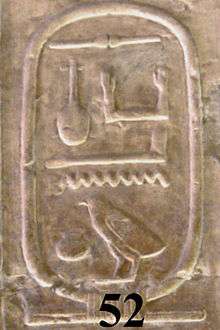Neferkamin Anu
| Neferkamin Anu | |||||||||||||||||||||||||||||||||||||||
|---|---|---|---|---|---|---|---|---|---|---|---|---|---|---|---|---|---|---|---|---|---|---|---|---|---|---|---|---|---|---|---|---|---|---|---|---|---|---|---|
| Sneferka Anu, Seneferka Any, Nefer, Nufe | |||||||||||||||||||||||||||||||||||||||
 The cartouche of Neferkamin Anu on the Abydos King List reading Sneferka Anu. | |||||||||||||||||||||||||||||||||||||||
| Pharaoh | |||||||||||||||||||||||||||||||||||||||
| Reign | c. 2170 BC (7th/8th Dynasty) | ||||||||||||||||||||||||||||||||||||||
| Predecessor | Neferkare Pepiseneb | ||||||||||||||||||||||||||||||||||||||
| Successor | Qakare Ibi | ||||||||||||||||||||||||||||||||||||||
| |||||||||||||||||||||||||||||||||||||||
Neferkamin Anu was a pharaoh of ancient Egypt during the First Intermediate Period. According to the Abydos King List and the latest reconstruction of the Turin canon by Kim Ryholt, he was the 13th king of the combined 7th/8th Dynasty.[3] This opinion is shared by the egyptologists Jürgen von Beckerath, Thomas Schneider and Darell Baker.[4][5][6] As a pharaoh of the 7th/8th Dynasty, Neferkamin Anu would have reigned over the Memphite region.
Attestations
Neferkamin Anu is mentioned on the entry 52 of the Abydos King list, which was compiled in the early Ramesside period. The list names his predecessor as Neferkare Pepiseneb and his successor as Qakare Ibi. The Turin canon identifies Nerferkamin Anu with a Nefer mentioned on column 4, line 10 of the document, which is in agreement with the Abydos king list.[6][3] Any detail about Neferkamin Anu's reign is lost in a lacuna of the Turin canon.
Name
The name of Neferkamin Anu is translisterated as Neferkamin Anu even though it is reported as Sneferka Anu on the Abydos King list. The reason for this transliteration is that the hieroglyph sign O34, reading s, could replace the sign R22 for the god Min and reading Mn.[6]
References
- ↑ Alan H. Gardiner: The royal canon of Turin, Griffith Institute, New edition, ISBN 978-0900416484
- ↑ http://www.ancient-egypt.org/kings/07/0713_neferkamin_ii/titulary.html Neferkamin II
- 1 2 Kim Ryholt: "The Late Old Kingdom in the Turin King-list and the Identity of Nitocris", Zeitschrift für ägyptische, 127, 2000
- ↑ Jürgen von Beckerath: Handbuch der ägyptischen Königsnamen. Deutscher Kunstverlag, München/ Berlin 1984, ISBN 3-422-00832-2, p. 59, 187.
- ↑ Thomas Schneider: Lexikon der Pharaonen. Albatros, Düsseldorf 2002, ISBN 3-491-96053-3, p. 174.
- 1 2 3 Darrell D. Baker: The Encyclopedia of the Pharaohs: Volume I - Predynastic to the Twentieth Dynasty 3300–1069 BC, Stacey International, ISBN 978-1-905299-37-9, 2008, p. 263-264
| Preceded by Neferkare Pepiseneb |
Pharaoh of Egypt 7th/8th Dynasty |
Succeeded by Qakare Ibi |